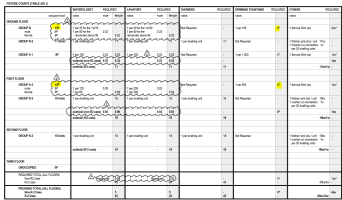steveray
SAWHORSE
As it pertains to drinking fountains specifically. What say you when you have Mutiple small occupancies for using the drinking fountain omission (<15 OL)? Should they be summed to push them over 15 or no when they are the same "building" occupancy (one tenancy), but mixed uses.....?

[P]2902.1.1
To determine the occupant load of each sex, the total occupant load shall be divided in half. To determine the required number of fixtures, the fixture ratio or ratios for each fixture type shall be applied to the occupant load of each sex in accordance with Table 2902.1. Fractional numbers resulting from applying the fixture ratios of Table 2902.1 shall be rounded up to the next whole number. For calculations involving multiple occupancies, such fractional numbers for each occupancy shall first be summed and then rounded up to the next whole number.
